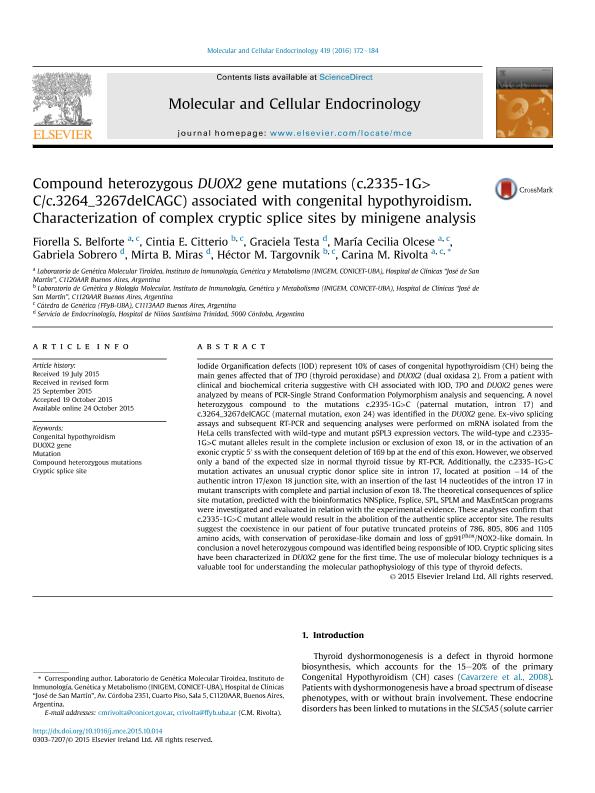Artículo
Compound heterozygous DUOX2 gene mutations (c.2335-1G>C/c.3264_3267delCAGC) associated with congenital hypothyroidism: Characterization of complex cryptic splice sites by minigene analysis
Belforte, Fiorella Sabrina ; Citterio, Cintia Eliana
; Citterio, Cintia Eliana ; Testa, Graciela; Olcese, María Cecilia; Sobrero, Gabriela; Miras, Mirta Beatriz; Targovnik, Hector Manuel
; Testa, Graciela; Olcese, María Cecilia; Sobrero, Gabriela; Miras, Mirta Beatriz; Targovnik, Hector Manuel ; Rivolta, Carina Marcela
; Rivolta, Carina Marcela
 ; Citterio, Cintia Eliana
; Citterio, Cintia Eliana ; Testa, Graciela; Olcese, María Cecilia; Sobrero, Gabriela; Miras, Mirta Beatriz; Targovnik, Hector Manuel
; Testa, Graciela; Olcese, María Cecilia; Sobrero, Gabriela; Miras, Mirta Beatriz; Targovnik, Hector Manuel ; Rivolta, Carina Marcela
; Rivolta, Carina Marcela
Fecha de publicación:
01/2016
Editorial:
Elsevier Ireland
Revista:
Molecular and Cellular Endocrinology
ISSN:
0303-7207
Idioma:
Inglés
Tipo de recurso:
Artículo publicado
Clasificación temática:
Resumen
Iodide Organification defects (IOD) represent 10% of cases of congenital hypothyroidism (CH) being the main genes affected that of TPO (thyroid peroxidase) and DUOX2 (dual oxidasa 2). From a patient with clinical and biochemical criteria suggestive with CH associated with IOD, TPO and DUOX2 genes were analyzed by means of PCR-Single Strand Conformation Polymorphism analysis and sequencing. A novel heterozygous compound to the mutations c.2335-1G>C (paternal mutation, intron 17) and c.3264_3267delCAGC (maternal mutation, exon 24) was identified in the DUOX2 gene. Ex-vivo splicing assays and subsequent RT-PCR and sequencing analyses were performed on mRNA isolated from the HeLa cells transfected with wild-type and mutant pSPL3 expression vectors. The wild-type and c.2335-1G>C mutant alleles result in the complete inclusion or exclusion of exon 18, or in the activation of an exonic cryptic 5' ss with the consequent deletion of 169 bp at the end of this exon. However, we observed only a band of the expected size in normal thyroid tissue by RT-PCR. Additionally, the c.2335-1G>C mutation activates an unusual cryptic donor splice site in intron 17, located at position -14 of the authentic intron 17/exon 18 junction site, with an insertion of the last 14 nucleotides of the intron 17 in mutant transcripts with complete and partial inclusion of exon 18. The theoretical consequences of splice site mutation, predicted with the bioinformatics NNSplice, Fsplice, SPL, SPLM and MaxEntScan programs were investigated and evaluated in relation with the experimental evidence. These analyses confirm that c.2335-1G>C mutant allele would result in the abolition of the authentic splice acceptor site. The results suggest the coexistence in our patient of four putative truncated proteins of 786, 805, 806 and 1105 amino acids, with conservation of peroxidase-like domain and loss of gp91phox/NOX2-like domain. In conclusion a novel heterozygous compound was identified being responsible of IOD. Cryptic splicing sites have been characterized in DUOX2 gene for the first time. The use of molecular biology techniques is a valuable tool for understanding the molecular pathophysiology of this type of thyroid defects.
Archivos asociados
Licencia
Identificadores
Colecciones
Articulos(INIGEM)
Articulos de INSTITUTO DE INMUNOLOGIA, GENETICA Y METABOLISMO
Articulos de INSTITUTO DE INMUNOLOGIA, GENETICA Y METABOLISMO
Citación
Belforte, Fiorella Sabrina; Citterio, Cintia Eliana; Testa, Graciela; Olcese, María Cecilia; Sobrero, Gabriela; et al.; Compound heterozygous DUOX2 gene mutations (c.2335-1G>C/c.3264_3267delCAGC) associated with congenital hypothyroidism: Characterization of complex cryptic splice sites by minigene analysis; Elsevier Ireland; Molecular and Cellular Endocrinology; 419; 1-2016; 172-184
Compartir
Altmétricas



